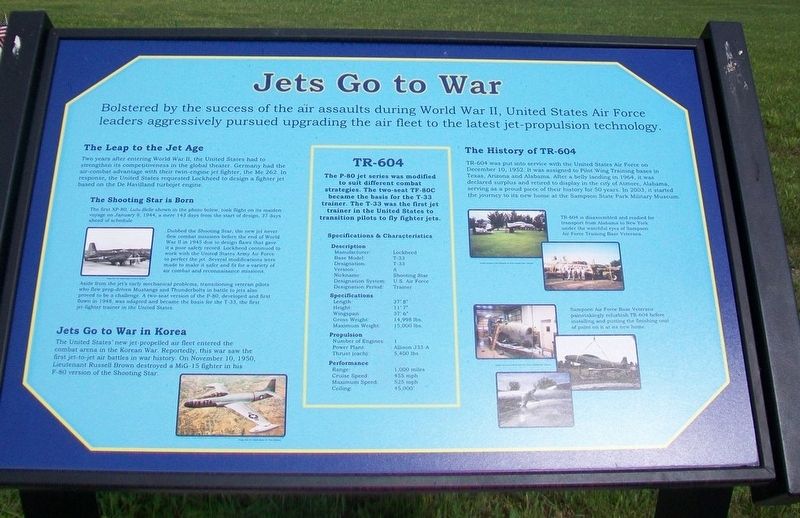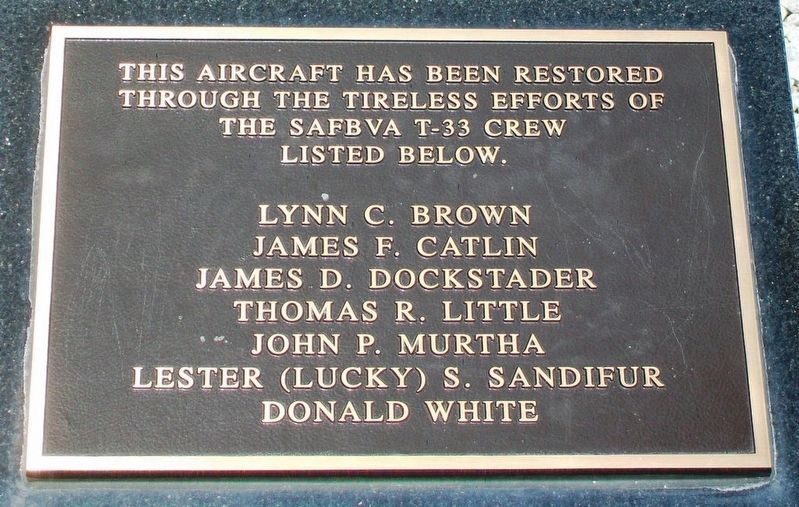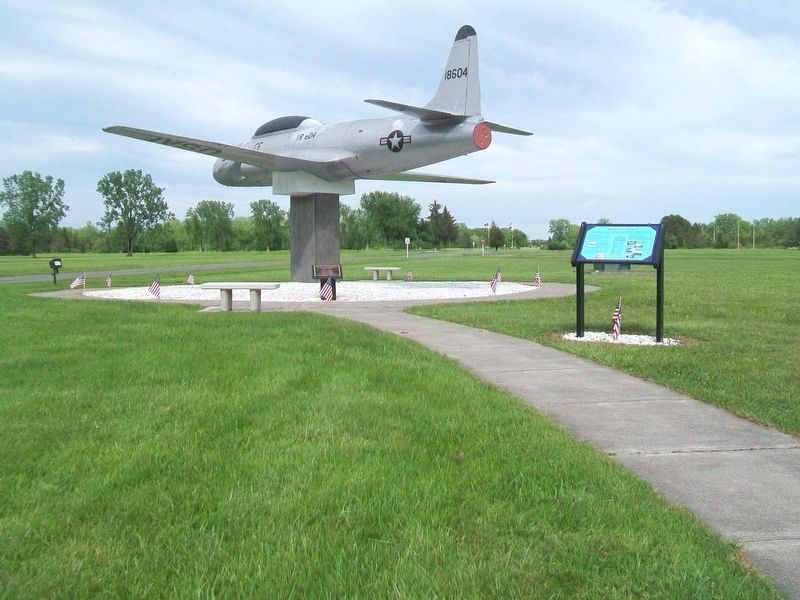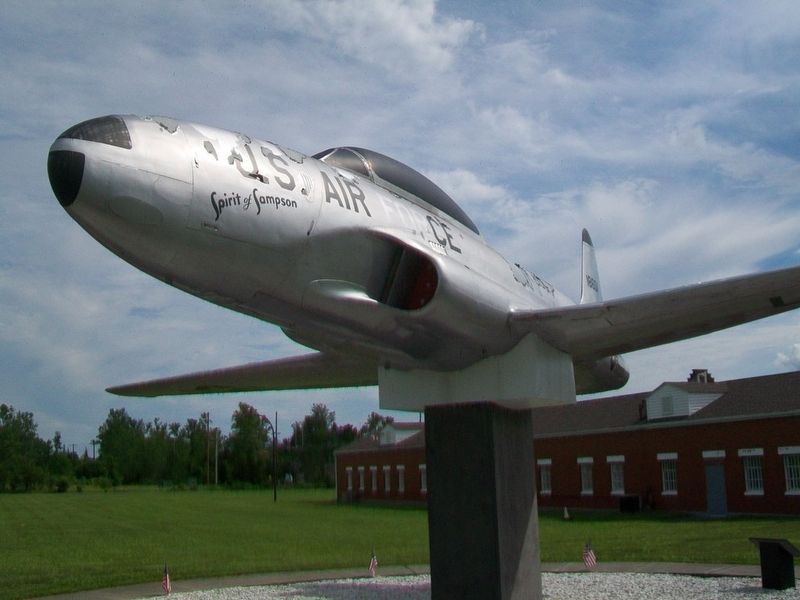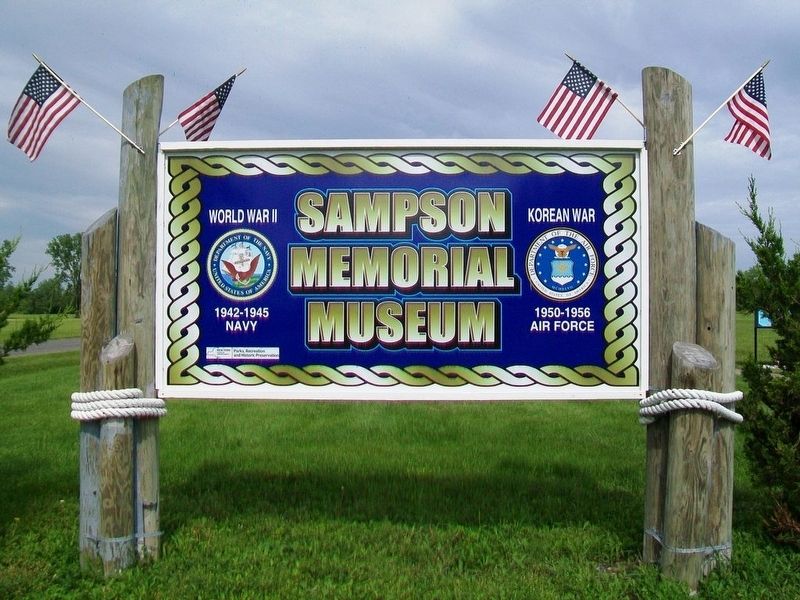Near Romulus in Seneca County, New York — The American Northeast (Mid-Atlantic)
Jets Go To War
Bolstered by the success of the air assaults during World War II, United States Air Force leaders aggressively pursued upgrading the air fleet to the latest jet-propulsion technology.
The Leap to the Jet Age
Two years after entering World War II, the United States had to strengthen its competitiveness in the global theater. Germany had the air-combat advantage with their twin-engine jet fighter, the Me 262. In response, the United States requested Lockheed to design a fighter jet based on the De Havilland turbojet engine.
The Shooting Star is born
The first XP-80, Lulu-Belle shown in the photo below, took flight on its maiden voyage on January 8, 1944, a mere 143 days from the start of design, 37 days ahead of schedule.
Dubbed the Shooting Star, the new jet never flew combat missions before the end of World War II in 1945 due to design flaws that gave it a poor safety record. Lockheed continued to work with the United States Army Air Force to perfect the jet. Several modifications were made to make it safer and fit for a variety of air combat and reconnaissance missions.
Aside from the jet's early mechanical problems, transitioning veteran pilots who flew prop-driven Mustangs and Thunderbolts in battle to jets also proved to be a challenge. A two-seat version of the P-80, developed and first flown in 1948, was adapted and became the basis for the T-33, the first jet-fighter trainer in the United States.
Jets Go to War in Korea
The United States' new jet-propelled air fleet entered the combat arena in the Korean War. Reportedly, this war saw the first jet-to-jet air battles in war history. On November 10, 1950, Lieutenant Russell Brown destroyed a MiG-15 fighter in his F-80 version of the Shooting Star.
The History of TR-604
TR-604 was put into service with the United States Air Force on December 10, 1952. It was assigned to Pilot Wing Training bases in Texas, Arizona and Alabama. After a belly landing in 1964, it was declared surplus and retired to display in the city of Atmore, Alabama, serving as a proud piece of their history for 50 years. In 2003, it started the journey to its new home at the Sampson State Park Military Museum.
[Photo captions read]
TR-604 is disassembled and readied for transport from Alabama to New York under the watchful eyes of Sampson Air Force Training Base Veterans.
Sampson Air Force Base Veterans painstakingly refurbish TR-604 before installing and putting the finishing coat of paint on it at its new home.
TR-604
The P-80 jet series was modified to suit different combat strategies. The two-seat TF-80C became the basis for the T-33 trainer. The T-33 was the first jet trainer in the United States to transition pilots to fly fighter jets.
Specifications & Characteristics
Description
Manufacturer: Lockheed
Base Model: T-33
Designation: T-33
Version: A
Nickname: Shooting Star
Designation System: U.S. Air Force
Designation Period: Trainer
Specifications
Length: 37' 8"
Height: 11' 7"
Wingspan: 37' 6"
Gross Weight: 14,998 lbs.
Maximum Weight: 15,000 lbs.
Propulsion
Number of Engines: 1
Power Plant: Allison J33-A
Thrust (each): 5,400 lbs.
Performance
Range: 1,000 miles
Cruise Speed: 455 mph
Maximum Speed: 525 mph
Ceiling: 45,000
This aircraft has been restored
through the tireless efforts of
the SAFBVA T-33 crew
listed below.
Lynn C. Brown
James F. Catlin
James D. Dockstader
Thomas R. Little
John P. Murtha
Lester (Lucky) S. Sandifur
Donald White
Topics. This memorial is listed in these topic lists: Air & Space • Man-Made Features • War, Cold • War, Korean. A significant historical date for this entry is January 8, 1944.
Location. 42° 43.717′ N, 76° 54.314′ W. Marker is near Romulus, New York, in Seneca County. Memorial is on the Sampson State Park Entrance Drive, on the left when traveling west. Marker and T-33 are on the grounds of the Sampson Memorial Museum. Touch for map. Marker is at or near this postal address: Sampson State Park, 6096 NY Route 96A, Romulus NY 14541, United States of America. Touch for directions.
Other nearby markers. At least 8 other markers are within walking distance of this marker. Anchors Aweigh (within shouting distance of this marker); Portal to Air Power (within shouting distance of this marker); Sampson Air Force Base Veterans Memorial (within shouting distance of this marker); Sampson Naval Training Base World War II Honored Dead (about 300 feet away, measured in a direct line); T-2C Buckeye (about 400 feet away); The Sampson State Park Experience (approx. 0.6 miles away); U. S. Naval Training Station & Center 1942-1946 (approx. 0.7 miles away); William Watts Folwell (approx. 0.7 miles away). Touch for a list and map of all markers in Romulus.
Also see . . .
1. T-33A Shooting Star General Info. Air Mobility Command website entry (Submitted on June 30, 2017, by William Fischer, Jr. of Scranton, Pennsylvania.)
2. Sampson Memorial Museum. USNTS Sampson website entry (Submitted on June 30, 2017, by William Fischer, Jr. of Scranton, Pennsylvania.)
Credits. This page was last revised on March 21, 2024. It was originally submitted on June 29, 2017, by William Fischer, Jr. of Scranton, Pennsylvania. This page has been viewed 260 times since then and 23 times this year. Photos: 1, 2, 3, 4, 5. submitted on June 30, 2017, by William Fischer, Jr. of Scranton, Pennsylvania.
